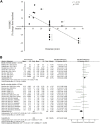DNA oxidation after exercise: a systematic review and meta-analysis
- PMID: 38028771
- PMCID: PMC10644354
- DOI: 10.3389/fphys.2023.1275867
DNA oxidation after exercise: a systematic review and meta-analysis
Abstract
Purpose: 8-Hydroxy-2'-deoxyguanosine (8-OHdG) is a byproduct of DNA oxidation resulting from free radical attacks. Paradoxically, treatment with 8-OHdG accelerates tissue healing. The aim of this study is to quantify the 8-OHdG response after a single session of exercise in both trained and untrained adults. Methods: A systematic review and meta-analysis of exercise intervention studies measuring changes in blood 8-OHdG following resistance exercise and aerobic exercise were conducted. The literature search included Web of Science, PubMed, BASE, and Scopus, with publications up to February 2023 included. Subgroup analysis of training status was also conducted. Results: Sixteen studies involving 431 participants met the eligibility criteria. Resistance exercise showed a medium effect on increasing circulating 8-OHdG levels (SMD = 0.66, p < 0.001), which was similar for both trained and untrained participants. However, studies on aerobic exercise presented mixed results. For trained participants, a small effect of aerobic exercise on increasing circulating 8-OHdG levels was observed (SMD = 0.42; p < 0.001). In contrast, for untrained participants, a large effect of decreasing circulating 8-OHdG levels was observed, mostly after long-duration aerobic exercise (SMD = -1.16; p < 0.05). Similar to resistance exercise, high-intensity aerobic exercise (5-45 min, ≥75% VO2max) significantly increased circulating 8-OHdG levels, primarily in trained participants. Conclusion: Pooled results from the studies confirm an increase in circulating 8-OHdG levels after resistance exercise. However, further studies are needed to fully confirm the circulating 8-OHdG response to aerobic exercise. Increases in 8-OHdG after high-intensity aerobic exercise are observed only in trained individuals, implicating its role in training adaptation. Systematic Review Registration: [https://Systematicreview.gov/], identifier [CRD42022324180].
Keywords: 8-Hydroxy-2’-deoxyguanosine; 8-OHdG; 8-dihydro-2’-deoxyguanosine; 8-oxo-7; 8-oxodG; ROS; free radicals; oxidative DNA damage.
Copyright © 2023 Ye, Dewi, Liao, Nicholls, Huang and Kuo.
Conflict of interest statement
The authors declare that the research was conducted in the absence of any commercial or financial relationships that could be construed as a potential conflict of interest.
Figures





References
Publication types
LinkOut - more resources
Full Text Sources
Miscellaneous

